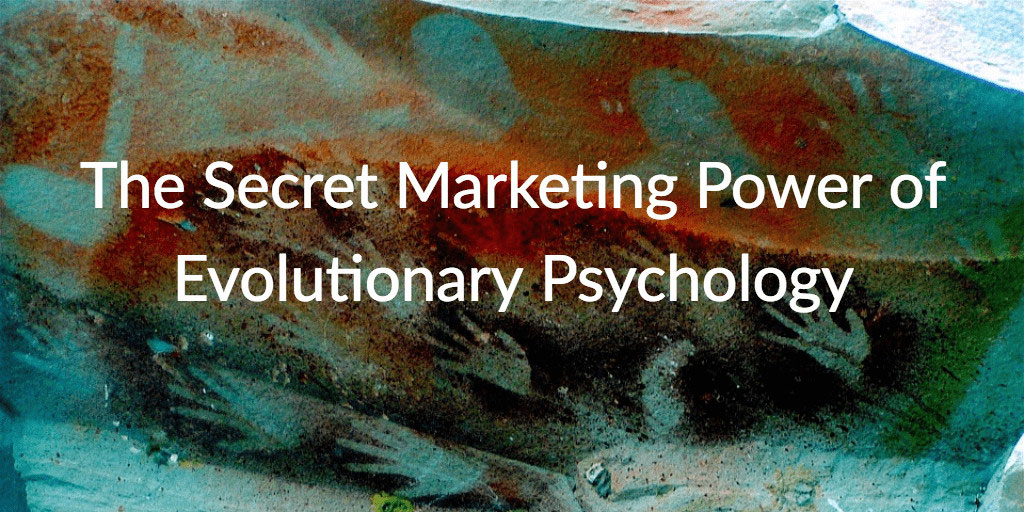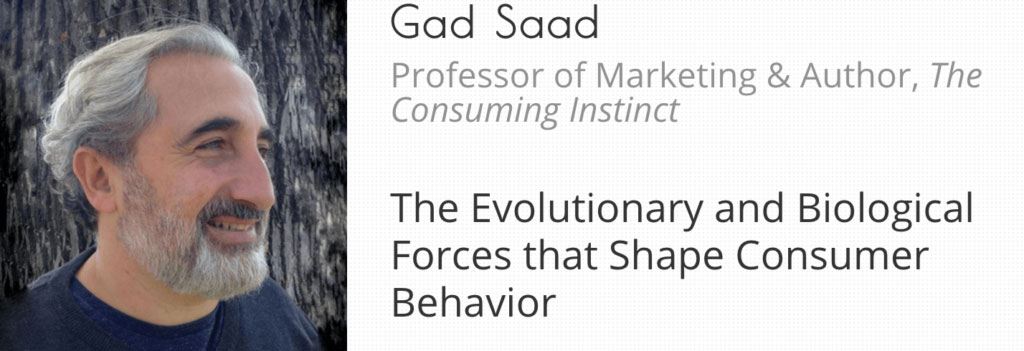Nir’s Note: Gad Saad is a professor of marketing at Concordia University and the author of The Consuming Instinct. He’ll be speaking at the upcoming Habit Summit in April. (You can register here!) In this interview with Max Ogles, Saad discusses the role of evolutionary psychology in modern marketing.
Q: Let’s start with a simple question: What is evolutionary psychology?
Gad Saad: Evolutionary psychology is applying evolutionary theory to understand the human mind. Evolution is typically used to explain all biological diversity, from how flowers evolved, to how a particular trait of an animal evolves. For example, why does the peacock have its tail that way that it does? The exact same tools of biology apply when we’re trying to understand the human mind. Put simply, evolutionary psychology is the pursuit of understanding the human mind through an evolutionary lens.
Q: Now to dive deeper, what are some of the specific tenets of evolutionary psychology?
GS: The first thing that evolutionary psychologists argue is that the forces of natural selection and sexual selection that are operative in biology can be used to explain psychology. In the game of life, there are two things that need to happen: First, I need to survive, then I need to mate. I can only extend my genes if both of those things happen. We uncover the adaptive problems that humans would have faced recurrently in the past, that would result in the human mind developing computational systems to solve these problems.
Secondly, evolutionary psychologists argue that the human mind is an amalgamation of both domain-general mechanisms and domain-specific mechanisms. Domain general mechanisms are things like intelligence, which can be transported across domains. You can use intelligence to solve a calculus problem and also to read literature. Evolutionary psychologists argue that the human mind is also comprised of domain-specific mechanisms. This means that the human mind would also have specific computational systems to solve adaptive problems such as avoiding predators, seeking nutritious foods, etc. Domain-specific mechanisms are like a Swiss army knife, with many types of blades for specific functions.
Finally, evolutionary psychology implies that we aren’t born with empty minds that are subsequently filled with socialization. Instead, we come to the world with innate biological blueprints. This is precisely what allows a 3-month-old child to stare at a beautiful face longer than a non-beautiful face, without learning about beauty previously. So the final point is that humans are an amalgamation of their culture and their biology—we’re an inexplicable mix of both our biology and our environments.
Q: You’re known as an evolutionary psychologist AND an expert in consumer marketing. How do they fit together to form “evolutionary consumption”?
GS: In my first semester as an undergraduate student, I took an advanced social psychology course. The professor assigned us a book called Homicide by two seminal evolutionary psychologists, Margo Wilson and Martin Daley. In the book, they applied evolutionary principles to demonstrate that there are certain criminal behaviors that transcend time and culture. You might go to the Yanomami tribe of the Amazon and see patterns of criminality that are exactly the same as those in Oxford, England.
As I flipped through those pages of that book in fall 1990, my epiphany happened. I knew that I was going to pursue my PhD studying consumer behavior. Then when I saw this unbelievably powerful framework, I wanted to take those evolutionary principles and use them to study consumer behavior. And that’s how the theory of evolutionary consumption developed.
Q: What types of things do you study in evolutionary consumption?
GS: The idea is to apply evolutionary principles to study our behaviors, choices, and preferences when we put on our consumer hats. But here’s the interesting part: I defined consumer behavior very broadly. So it’s not just consuming Coca Cola, Starbucks, or jeans, but also friendships, religious narratives, cultural products, etc. I look at consumption with a capital C. I argue that if you want to really understand universal consumer drives, then you really can’t have a full understanding if you leave biology out of the equation.
If you’re looking for even more research on this topic, then I invite you to download my 18-lesson PDF course on Product Psychology. I’ve asked the brightest minds in the field to share their best resources on user behavior:
Q: One frequent topic in your research is gender. What’s something product managers and marketers should know about gender that would help them interact with customers more effectively?
GS: Let’s suppose I’m Coca Cola developing an advertising campaign from Atlanta. Should I develop a global message that I transport across cultures? Or should I have local advertising whereby I tweak the message to fit all the cross differences? This local versus global debate has been going on for 80 years, and that hasn’t been resolved.
<I say you can solve this practical problem through an understanding of evolutionary psychology. There are certain things in advertising that are universally understood in exactly the same way. If I use a facially symmetric endorser when I’m selling a beauty product, there is no culture that would respond with, “Oh gee, why did they pick that person? They’re so ugly.” Because facial symmetry is understood the same way across cultures as a universal marker of beauty.
But this doesn’t hold true for color connotations. Green might be construed as a symbol of disease in one culture and as a symbol of fertility in another culture. Therefore, understanding which cues in advertising are universally transportable and which ones are culturally determined is very much within what evolutionary psychology allows you to do.
This interview has been edited for length and clarity. Learn more from Gad Saad and many other behavioral design experts at the upcoming Habit Summit! You can register here.
Related Articles
- Schedule Maker: a Google Sheet to Plan Your Week
- Cancel the New York Times? Good Luck Battling “Dark Patterns”
- How to Start a Career in Behavioral Design
- A Free Course on User Behavior
- User Investment: Make Your Users Do the Work
- Variable Rewards: Want To Hook Users? Drive Them Crazy
- The Hooked Model: How to Manufacture Desire in 4 Steps


